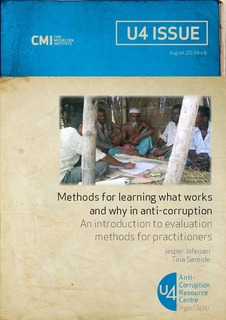Methods for learning what works and why in anti-corruption: An introduction to evaluation methods for practitioners
Research report
Permanent lenke
http://hdl.handle.net/11250/2475161Utgivelsesdato
2013-08-01Metadata
Vis full innførselSamlinger
- Publications [1488]
Originalversjon
Bergen: Chr. Michelsen Institute (U4 Issue 2013:8) 40 p.Sammendrag
Evaluations of donor-funded anti-corruption reforms and programmes would benefit from upgrading and diversifying the methods used to document effects. Better evaluations in turn would improve the evidence base for the effectiveness of specific anti-corruption interventions. Using real and hypothetical examples, this paper offers practical guidance to practitioners who design, implement, and disseminate evaluations and research on anti-corruption. A range of quantitative and qualitative methods can be used to answer operational questions on the impact of anti-corruption interventions. Some methods can produce stronger evidence than others for a specific evaluation, but there are tradeoffs between rigour and costs, and between aspiration and feasibility. Donors should let the evaluation question, programme attributes, and availability of data determine the most appropriate methods for a given study. With careful planning and adequate resources, donors can use many of the methods presented in this paper. This should give more reliable results and produce needed knowledge on what works in anti-corruption, laying the basis for more effective anti-corruption initiatives.
